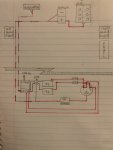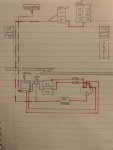Stickyskilet
Cadet
- Joined
- May 22, 2019
- Messages
- 14
I bought a 16’ aluminum open boat last summer, with 2 Scotty 1106 electric downriggers, a bilge pump and a sounder. It was wired up with two group24 deep cycles through a 1/2/both/off switch with a guest onboard 2 bank charger and alternator module. Power is a 2005 Yamaha f25 manual start, that has a non OEM rectifier/regulator wired up to the chargers alternator module.
The batteries that were in it were pretty weak, with quick discharge, and incomplete charging towards the end of last summer. They limped through without major issue.
I recently replaced both batteries, and wired everything up exactly as it had been, and when I connected the positive leads between each battery and the switch(which was in the off position), the charger made a few “pop” sounds, until the positive leads were removed from the batteries. The charger was warm, and bulged... don’t know for sure whether it was that way prior to the “pops”, but I don’t think so.
I also have reservations about the rectifier, as at one point last summer, the finder was seeing a voltage of almost 17v.
So long term, I plan on getting a new onboard charger, and wiring it up as it should be, but I have a trip coming up next week that I need to have things working for.
My feeling is that I should be able to wire up the batteries with the positive lead from each to the corresponding input on the switch, the switch common output going through the 70A breaker to the loads at the rear of the boat, and negative leads both going to a ground post in the battery compartment, and then on to the ground post at the rear of the boat. I would also pull the fuse from the rectifier, taking that out of the picture along with the blown charger.
I’d be happy to hear from anyone about any issues with this plan, as well as any general thoughts about how you’d wire things up for two electric downriggers, a 55lb trolling motor, a small sounder, bilge pump and running lights.
Thanks.
The batteries that were in it were pretty weak, with quick discharge, and incomplete charging towards the end of last summer. They limped through without major issue.
I recently replaced both batteries, and wired everything up exactly as it had been, and when I connected the positive leads between each battery and the switch(which was in the off position), the charger made a few “pop” sounds, until the positive leads were removed from the batteries. The charger was warm, and bulged... don’t know for sure whether it was that way prior to the “pops”, but I don’t think so.
I also have reservations about the rectifier, as at one point last summer, the finder was seeing a voltage of almost 17v.
So long term, I plan on getting a new onboard charger, and wiring it up as it should be, but I have a trip coming up next week that I need to have things working for.
My feeling is that I should be able to wire up the batteries with the positive lead from each to the corresponding input on the switch, the switch common output going through the 70A breaker to the loads at the rear of the boat, and negative leads both going to a ground post in the battery compartment, and then on to the ground post at the rear of the boat. I would also pull the fuse from the rectifier, taking that out of the picture along with the blown charger.
I’d be happy to hear from anyone about any issues with this plan, as well as any general thoughts about how you’d wire things up for two electric downriggers, a 55lb trolling motor, a small sounder, bilge pump and running lights.
Thanks.





















